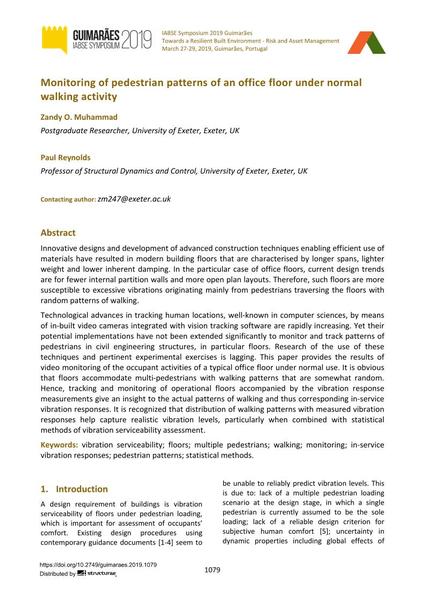Monitoring of pedestrian patterns of an office floor under normal walking activity

|
|
|||||||||||
Bibliographic Details
| Author(s): |
Zandy O. Muhammad
(Postgraduate Researcher, University of Exeter, Exeter, UK)
Paul Reynolds (Professor of Structural Dynamics and Control, University of Exeter, Exeter, UK) |
||||
|---|---|---|---|---|---|
| Medium: | conference paper | ||||
| Language(s): | English | ||||
| Conference: | IABSE Symposium: Towards a Resilient Built Environment Risk and Asset Management, Guimarães, Portugal, 27-29 March 2019 | ||||
| Published in: | IABSE Symposium Guimarães 2019 | ||||
|
|||||
| Page(s): | 1079-1083 | ||||
| Total no. of pages: | 5 | ||||
| DOI: | 10.2749/guimaraes.2019.1079 | ||||
| Abstract: |
Innovative designs and development of advanced construction techniques enabling efficient use of materials have resulted in modern building floors that are characterised by longer spans, lighter weight and lower inherent damping. In the particular case of office floors, current design trends are for fewer internal partition walls and more open plan layouts. Therefore, such floors are more susceptible to excessive vibrations originating mainly from pedestrians traversing the floors with random patterns of walking. Technological advances in tracking human locations, well-known in computer sciences, by means of in-built video cameras integrated with vision tracking software are rapidly increasing. Yet their potential implementations have not been extended significantly to monitor and track patterns of pedestrians in civil engineering structures, in particular floors. Research of the use of these techniques and pertinent experimental exercises is lagging. This paper provides the results of video monitoring of the occupant activities of a typical office floor under normal use. It is obvious that floors accommodate multi-pedestrians with walking patterns that are somewhat random. Hence, tracking and monitoring of operational floors accompanied by the vibration response measurements give an insight to the actual patterns of walking and thus corresponding in-service vibration responses. It is recognized that distribution of walking patterns with measured vibration responses help capture realistic vibration levels, particularly when combined with statistical methods of vibration serviceability assessment. |
||||
| Keywords: |
floors walking vibration serviceability monitoring statistical methods multiple pedestrians in-service vibration responses pedestrian patterns
|
||||
